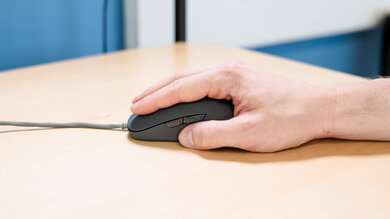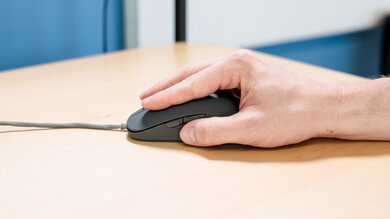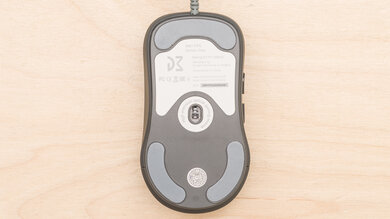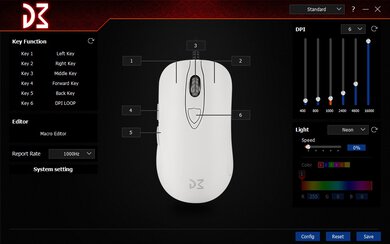The Dream Machines DM1 FPS is a wired gaming mouse with a matte grey plastic body with a soft-touch texture, two side buttons on the left, and a dedicated CPI button behind the scroll wheel. It has a symmetrical, ambidextrous shape suitable for all grip types and most hand sizes. However, small hands may have difficulty hitting the front side button using a claw grip, and small or medium-sized hands may have the same issue using a fingertip grip. It feels decently well-built, but our unit suffers from some build quality issues, including a loose scrolling wheel that isn't very precise and the ability to actuate the side buttons if you squeeze into the plastic frame below them with enough pressure. That said, it also has a low lift-off distance, a wide CPI range, and good click latency. However, if you play fast-paced or competitive games, you may prefer a more responsive-feeling option.
Our Verdict
The Dream Machines DM1 FPS is okay for office use, but it doesn't have any wireless connection options. Also, its scroll wheel doesn't have L/R tilt buttons or a free-scrolling mode. Nevertheless, it feels decently sturdy and has a comfortable, ambidextrous shape suitable for all grip types and most hands sizes. You can also reprogram all buttons using the customization software, and all default button functions work in Windows and macOS.
-
Comfortable, ambidextrous shape suitable for all grip types and most hand sizes.
-
All buttons are reprogrammable.
-
Wired only.
-
Scroll wheel lacks L/R tilt buttons and a free-scrolling mode.
The Dream Machines DM1 FPS is a good FPS gaming mouse. It's lightweight and feels decently well-built. The unit we tested suffers from some build quality issues, but they're unlikely to present problems during normal use. That said, it has a flexible, paracord-like cable and a comfortable, ambidextrous shape suitable for all grip types and most hand sizes. Performance-wise, it has a wide CPI range, a low lift-off distance, and good click latency, though competitive gamers may prefer a more responsive-feeling option. Unfortunately, you can only adjust the CPI by increments of 200, which isn't as precise as the adjustments you can make on many similar gaming mice.
-
Good click latency.
-
Comfortable, ambidextrous shape suitable for all grip types and most hand sizes.
-
Fairly lightweight.
-
CPI is only adjustable by increments of 200.
The Dream Machines DM1 FPS is adequate for MMO gaming, but it doesn't have nearly as many side buttons as a dedicated MMO gaming mouse. That said, it feels decently well-built and has an ambidextrous shape suitable for all grip types and most hand sizes. It also has a low lift-off distance, a wide CPI range, and a good click latency, though some may prefer a more responsive-feeling option. Unfortunately, you can only adjust the CPI by increments of 200, which isn't as precise as most gaming mice. Also, there's no way to set custom profiles using the customization software.
-
Good click latency.
-
Comfortable, ambidextrous shape suitable for all grip types and most hand sizes.
-
All buttons are reprogrammable.
-
Not nearly as many side buttons as a dedicated MMO gaming mouse.
-
CPI is only adjustable by increments of 200.
-
Scroll wheel lacks L/R tilt buttons.
The Dream Machines DM1 FPS is a great ultra-light gaming mouse. It's fairly lightweight, but it's at the heaviest end of what we would consider a lightweight mouse. That said, it feels decently well-built and has a comfortable, ambidextrous shape suitable for all grip types and most hand sizes. It also has a flexible, paracord-like cable, a low lift-off distance, and a wide CPI range. Unfortunately, its feet don't glide as smoothly as most other lightweight gaming mice, and while it has good click latency, some gamers may prefer a more responsive-feeling option.
-
Good click latency.
-
Comfortable, ambidextrous shape suitable for all grip types and most hand sizes.
-
Fairly lightweight.
-
Mouse feet don't glide as smoothly as those on many similar gaming mice.
The Dream Machines DM1 FPS is inadequate for travel as it's bulky and has no wireless connection options, making it cumbersome to use in tight spaces like buses, trains, or planes. That said, it feels decently well-built and has an ambidextrous shape suitable for all grip types and most hand sizes. It also has onboard memory for using custom settings on devices without the software installed.
-
Comfortable, ambidextrous shape suitable for all grip types and most hand sizes.
-
Wired only.
-
Bulky; may not fit in most laptop cases.
- 6.7 Office/Multimedia
- 7.9 Video Games (FPS)
- 6.9 Video Games (MMO)
- 8.2 Ultra-Light Gaming
- 5.2 Travel
- Updated Oct 08, 2021: Review published.
- Updated Oct 06, 2021: Early access published.
- Updated Jul 08, 2021: Our testers have started testing this product.
- Updated Jul 05, 2021: The product has arrived in our lab, and our testers will start evaluating it soon.
- Updated May 15, 2021: We've purchased the product and are waiting for it to arrive in our lab.
Differences Between Sizes And Variants
The Dream Machines DM1 FPS we tested is the Smoke Grey, which is a matte textured variant. It's also available in seven other texture/color variants. The additional matte textured variants include Raven Black, Noir, and Blizzard White, while the glossy textured variants include Ocean Blue, Blood Red, Pearl White, and Onyx Black. You can see the label for our Dream Machines DM1 FPS unit here.
Compared To Other Mice
The Dream Machines DM1 FPS is a good wired gaming mouse and a continuation of the DM1 lineup. Its ambidextrous shape is similar to the original SteelSeries Sensei mice, specifically the SteelSeries Sensei Ten. Unlike some other gaming mice, it only has one small RGB lighting zone in the scroll wheel, and it serves primarily as a CPI indicator rather than a decorative element. This mouse also has a PixArt PMW3389 sensor, widely seen as one of the best gaming mouse sensors available. Unfortunately, you can't adjust the CPI as precisely as you can on other premium gaming mice using the same sensor. There's also no way to adjust the lift-off distance, and some gamers may prefer the default were lower.
For more options, see our recommendations for the best mouse, the best wired mouse, and the best gaming mouse.
The GLORIOUS Model O is a better wired gaming mouse than the Dream Machines DM1 FPS. The GLORIOUS is lighter and feels better built. It also has a more flexible paracord-like cable and mouse feet that glide more smoothly. Performance-wise, it has a more precisely adjustable CPI, a more consistent sensor, a lower click latency, a lower lift-off distance, and the ability to create custom profiles, a feature the Dream Machines lacks. On the other hand, the Dream Machines has a broader CPI range. Both mice are suitable for all grip types and nearly the same range of hand sizes, but the Dream Machines is suitable for small hands using a palm grip, while the GLORIOUS isn't.
The BenQ ZOWIE S1 and the Dream Machines DM1 FPS are wired gaming mice with comparable performance. The BenQ feels sturdier and has better quality mouse feet. On the other hand, The Dream Machines is somewhat lighter and has a more flexible cable. It also has a wider CPI range and has customization software, which the BenQ lacks.
The Razer Viper Mini is a better, wired gaming mouse than the Dream Machines DM1 FPS. The Razer is quite a bit lighter and feels better built. It also has mouse feet that glide more smoothly, much lower click latency, and you can adjust the CPI more precisely. You can also assign a HyperShift button to configure a secondary layer of commands. On the other hand, the Dream Machines has a higher maximum CPI.
The HyperX Pulsefire FPS Pro and the Dream Machines DM1 FPS are wired gaming mice with comparable performance. The HyperX feels sturdier and has a more precisely adjustable CPI. It also has lower click latency, and you can set custom profiles using the customization software, which is a feature the Dream Machines lacks. On the other hand, the Dream Machines is lighter and has slightly better mouse feet. It also has a more flexible paracord-like cable. The Dream Machines also has an ambidextrous shape, while the HyperX has a right-handed shape. Both mice are suitable for all grip types and most hand sizes, but the HyperX is suitable for medium-sized hands using a fingertip grip while the Dream Machines isn't.
The GLORIOUS Model D is a better wired gaming mouse than the Dream Machines DM1 FPS. The GLORIOUS is lighter and has a more flexible cable. It also has mouse feet that glide more smoothly, lower click latency, and can create custom profiles using the customization software, which is a feature the Dream Machines lacks. On the other hand, the Dream Machines has a wider CPI range. The GLORIOUS has a right-handed shape, while the Dream Machines has an ambidextrous shape. Both mice are suitable for all grip types and nearly all hand sizes.
The Logitech G PRO X SUPERLIGHT is a better gaming mouse than the Dream Machines DM1 FPS. The Logitech connects either wirelessly with its USB receiver or with its charging cable. It's significantly lighter and feels sturdier. It also has mouse feet that glide more smoothly, a wider CPI range, a more precisely adjustable CPI, a lower lift-off distance, and lower click latency. Its customization software is also compatible with Windows and macOS, while the software for the Dream Machines is only compatible with Windows. On the other hand, the Dream Machines has RGB lighting, which the Logitech lacks.
The BenQ ZOWIE EC3-C and the Dream Machines DM1 FPS are wired gaming mice with comparable performance. The BenQ is somewhat lighter and feels better built. It also has mouse feet that glide more smoothly, a more consistent sensor, and marginally lower click latency. On the other hand, the Dream Machines has a wider CPI range and lets you adjust the CPI by steps of 200, while the BenQ only has four default CPI presets. The Dream Machines also has customization software, which the BenQ lacks.
Test Results
If you're looking for a mouse with a similar style and performance but with an RGB lighting zone in a strip around the bottom that casts downwards onto your desk or mousepad, check out the Razer Abyssus Essential.
There's minor creaking when pressure is applied to the body of the Dream Machines DM1 FPS and slight flex with enough pressure applied to the underside. Also, you can actuate the side buttons by pressing hard enough into the body below them, and the scroll wheel feels loose and rattles if you shake the mouse. Lastly, we found the mouse isn't completely level and rocks back and forth slightly on flat surfaces.
For a similar wired gaming mouse with an ergonomic, right-handed shape, check out the BenQ ZOWIE EC1-C.
The available polling rate settings on the Dream Machines DM1 FPS are 125Hz, 250Hz, 500Hz, and 1000Hz. You can set up to six CPI settings and cycle between them using the button behind the scroll wheel by default. The sensor on our unit is somewhat inconsistent and overshoots the set CPI by 10,7% during slow cursor movements and 1.4% during fast cursor movements.
You can reprogram all of the buttons on the Dream Machines DM1 FPS. However, you can't reprogram the up/down inputs on the scroll wheel.
The download link on the manufacturer's website for the Dream Machines DM1 FPS customization software is broken. We downloaded the software from a third-party site for our testing. We found the software lacked several common features, including an option to adjust the lift-off distance and the ability to configure custom profiles.













